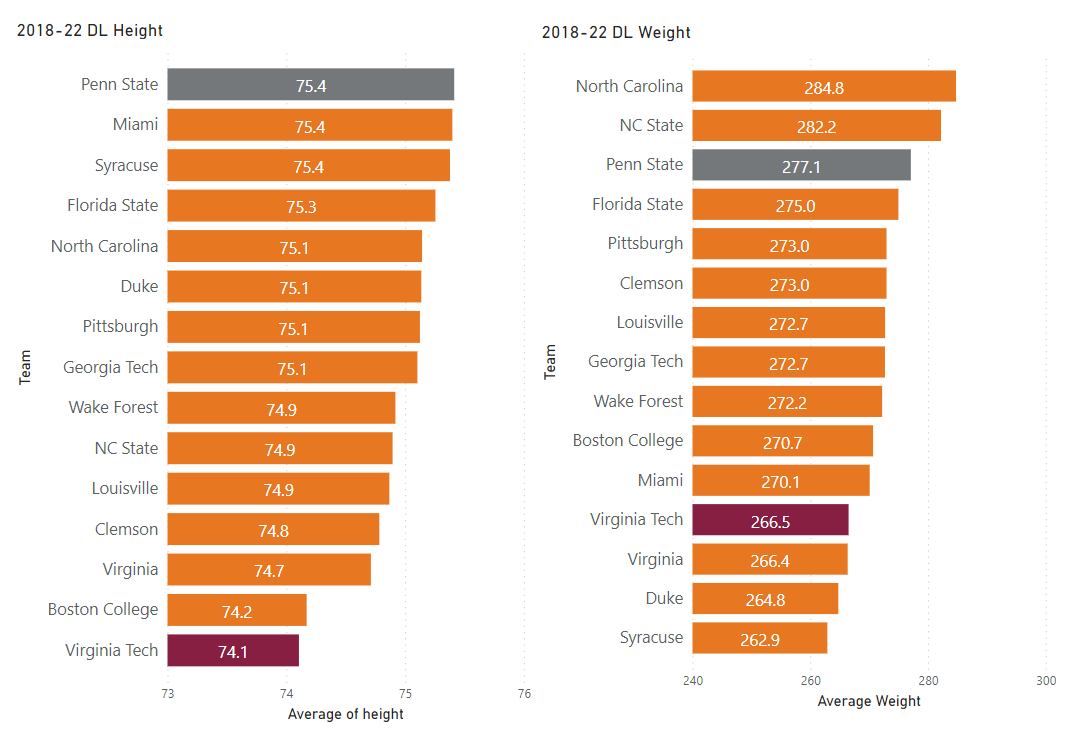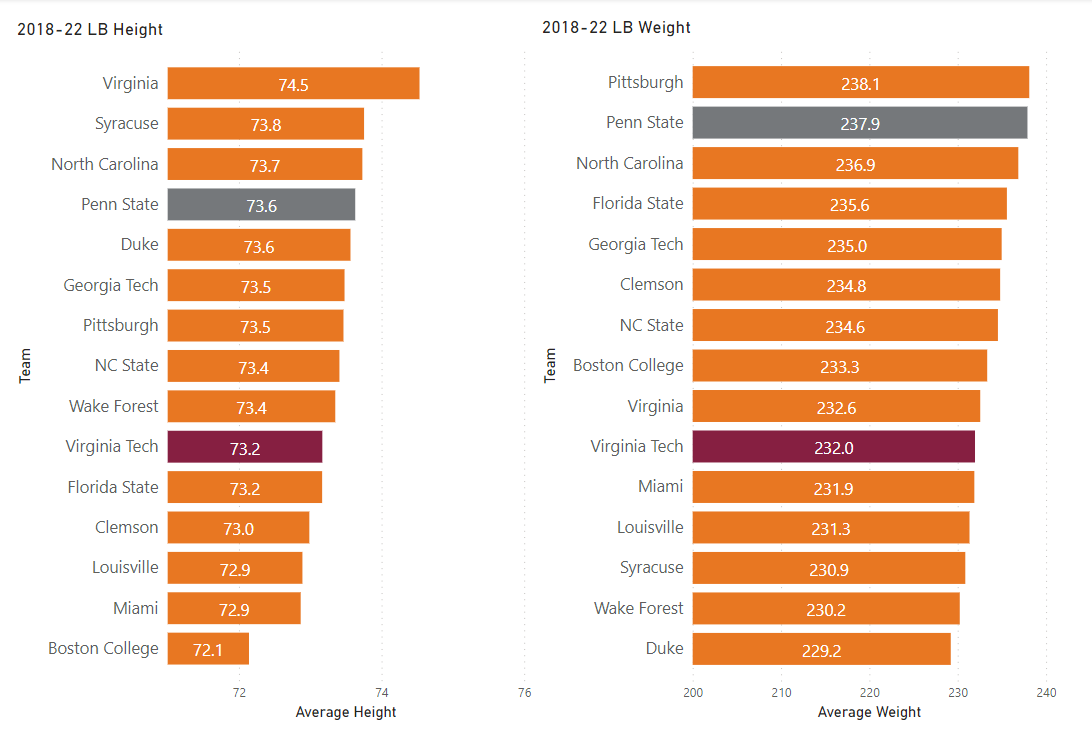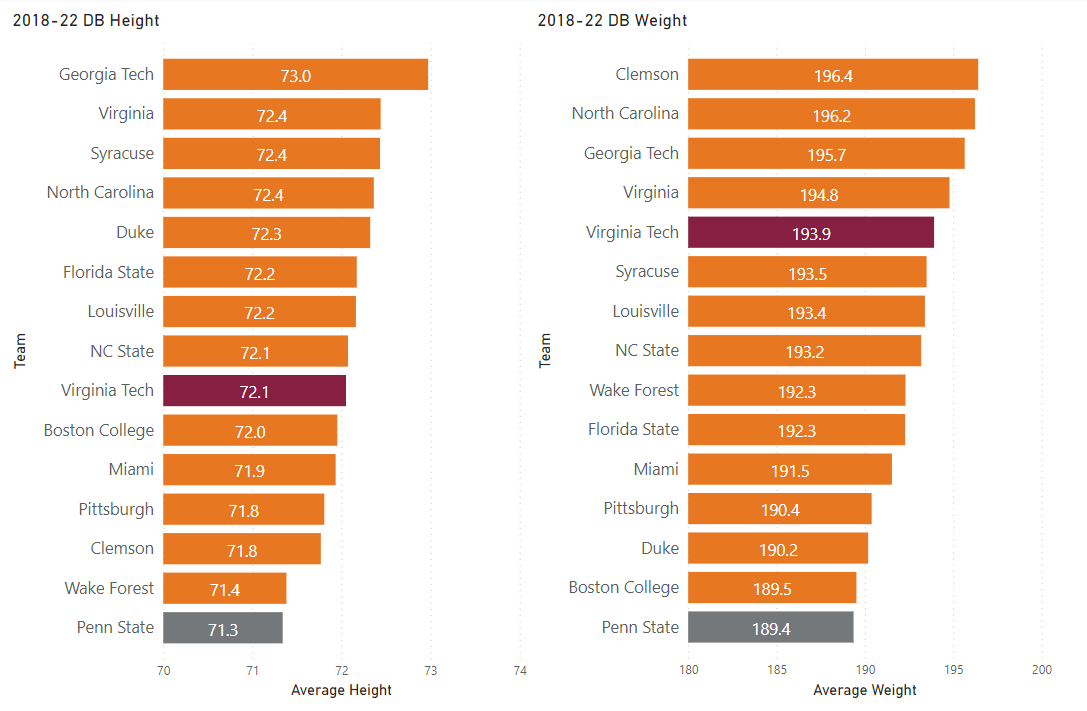Brent Pry's Defensive Player Template
Pry's defense is an evolution of Bud Foster's, but some of the player shapes and sizes will be different
If you had to pick one Virginia Tech defense in the history of the program that best passed the eye test, what year would it be?
My answer: 2005.
That was the first of two straight top-ranked defenses by yards allowed. While the 2006 team put up the better numbers (with an assist from the schedule), the 2005 team had, by far, more talent.
How much more?
Well, take the 2006 defense, then add NFL draft picks Jimmy Williams (2nd round), Darryl Tapp (2nd), James Anderson (3rd), Jonathan Lewis (6th), and Justin Hamilton (7th).
As a refresher, here is a list of the defensive starters in 2005, along with their official heights and weights:
Darryl Tapp, DE - 6’1”, 265 lbs.
Jonathan Lewis, DT - 6’1”, 296 lbs.
Carlton Powell, DT - 6’2”, 292 lbs.
Chris Ellis, DE - 6’5”, 250 lbs.
Xavier Adibi, LB - 6’2”, 224 lbs.
Vince Hall, LB - 6’0”, 236 lbs.
James Anderson, LB - 6’3”, 232 lbs.
Jimmy Williams, CB - 6’3”, 216 lbs.
Roland Minor, CB - 6’0”, 205 lbs.
Justin Hamilton, FS - 6’3”, 222 lbs.
Aaron Rouse, ROV - 6’4”, 221 lbs.
The averages, by position group, among the starters were:
Defensive Line - 74.3 inches, 275.8 lbs.
Linebacker - 73.7 inches, 230.7 lbs.
Defensive Back - 74.5 inches, 216 lbs.
I write all that by way of preface. Consider the above to be as close to perfect as Virginia Tech has ever gotten. And realize, those were the measurements for the starters. The bench guys, including both the over- and underweight, were not included. Average weights for the entire defense were as follows:
Defensive Line - 279.0 lbs.
Linebacker - 224.4 lbs.
Defensive Back - 185 lbs.
What stands out immediately in the starters’ numbers is the size and length in the backend, as well as at linebacker. As Bud’s defenses went, this one was huge. In addition, the 31 lb. difference between the starting defensive backs and all defensive backs is noteworthy. Hamilton, Rouse, and Williams were uniquely gifted and blessed with incredible size. To my knowledge, never before and never since had Tech started such huge players in the secondary.
Brent Pry’s defense (yes, it’s still Pry’s, even if Marve is coordinating, in the same way that Alabama features Nick Saban’s defense) evolved from Foster’s, but there are some key differences in player types. So, first we’ll establish the Pry template, then we’ll examine the state of the Virginia Tech defense, and how much progress needs to be made.
Pry and Foster template differences
If we consider Penn St.’s defenses from 2018-2022, which, although he left for Blacksburg in December 2021, were essentially all built by Brent Pry, we can get a sense of the types of player body types with which he filled his rosters. Those averages are:
Defensive Line - 75.4 inches, 277.1 lbs.
Linebacker - 73.6 inches, 229.9 lbs.
Defensive Back - 71.3 inches, 189.4 lbs.
The quick takeaway is that in comparison Bud, Pry looked for more length up front, and was content to play with less length in the secondary.
The linebacker numbers (PSU last five years vs. 2005 VT) are nearly the same, but one must consider that the 2005 starting group was abnormally lengthy. In general, we should probably expect a taller linebacking core in 2026 than we saw in 2022, and already the two-deep in 2023 seems to be moving in that direction.
Baseline vs. the ACC and Penn St.
Bud was known to trade size for speed, quickness, and, in the case of defensive linemen, twitchiness. After Bud’s retirement, Hamilton sought to get more space eaters and more length on the defensive line. The length, especially, could have been a helpful lead-in for Pry. However, many of those players, especially in the 2020 class, quickly washed out of the program.
As a result, whereas Penn St. defensive linemen have been comparatively tall and heavy the last five years, Virginia Tech’s DL has been short and light. If one assumes a 50 lb. spread between the average DT and DE, then we’re looking at defensive tackles around 290 lbs. and defensive ends at 240 lbs. And it’s not like those smaller ends have been burners coming off the edge. Overall, there is still a lot of work to do up front.
Tech is in a much better position talent and size-wise at linebacker. In fact, if the defense clicks for everyone, we could see six different guys play meaningful snaps at the three linebacker positions.
From a size perspective, I would expect the 2023 Virginia Tech two-deep at linebacker to be much closer to the Penn St. averages. In fact, this could be the tallest linebacking corps we’ve seen in Blacksburg in recent memory. Keonta Jenkins, Jaden Keller, Alan Tisdale, Jayden McDonald, Keli Lawson, and Stone Snyder are all at least 6’3” tall.
The Hokies are already much bigger in the backend than Pry’s Penn St. teams were. But then again, so is every other ACC team - the Hokies are basically mid-pack in the conference.
It’s not like Tech is going to shrink its secondary. In fact, Cam Johnson, the lightest DB on the roster in 2022, transferred out earlier in the offseason.
Entering last season, I found it curious that Dorian Strong had not bulked up. He’s always been skinny, and we saw a lot of other guys get stronger. But looking at the Penn St. numbers makes me think agility is far and away the most important attribute for a Pry DB. The early evidence is that Pry will not hesitate to move a bigger safety (like Jenkins and J.R. Walker in 2022) to the SAM linebacker position.
The biggest difference between Pry and Bud from player template perspective is that Bud prioritized length in the backend, while Pry seems to value more length near the line of scrimmage. That, and much heavier defensive linemen.
The Hokies have been too small up front in recent years, and only average at linebacker and in the secondary compared to the rest of the ACC. The result has been a defense that wears down over time. Getting bigger at key positions (I’m looking at you d-line) will involve a combination of recruiting and strength and conditioning. Sadly, there is no quick fix.
Needless to say, I will be paying very close attention to the updated heights and weights when they are released in August. At that point, we should have a better understanding of how much progress has been made, and how much work still remains to be done.





